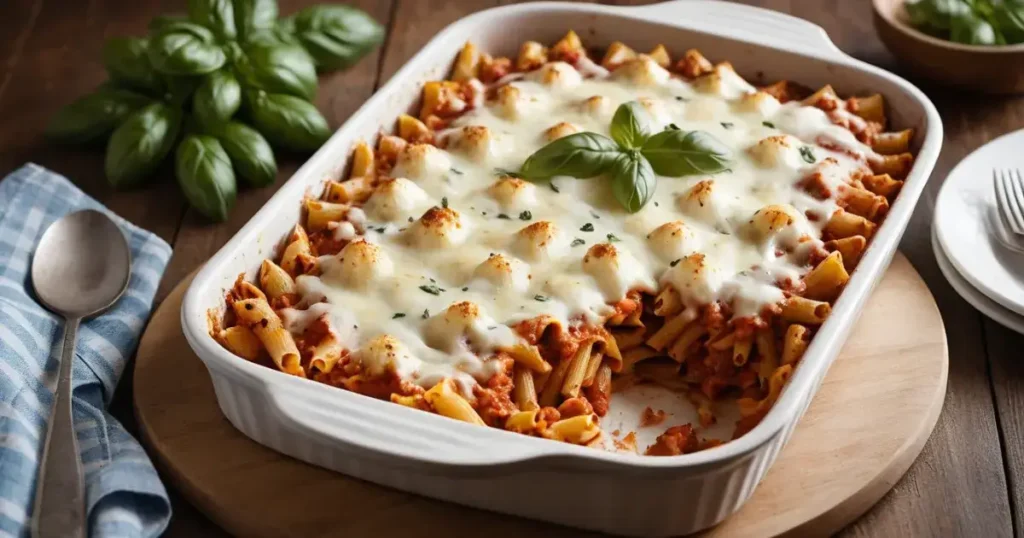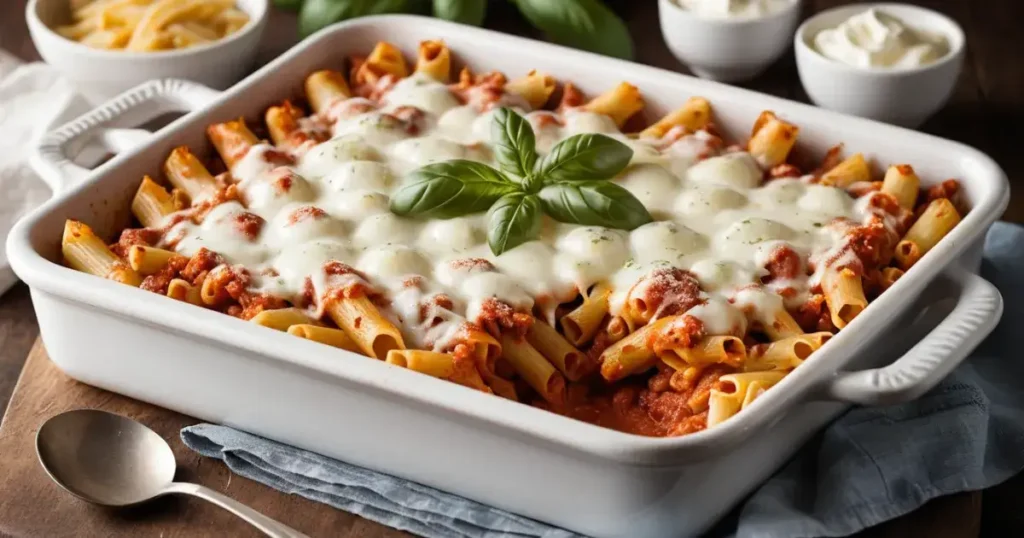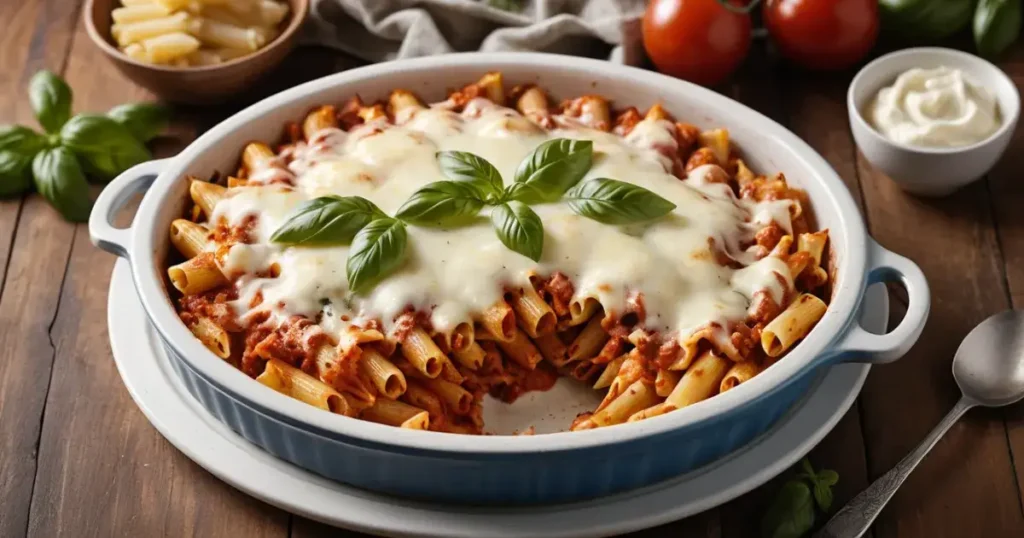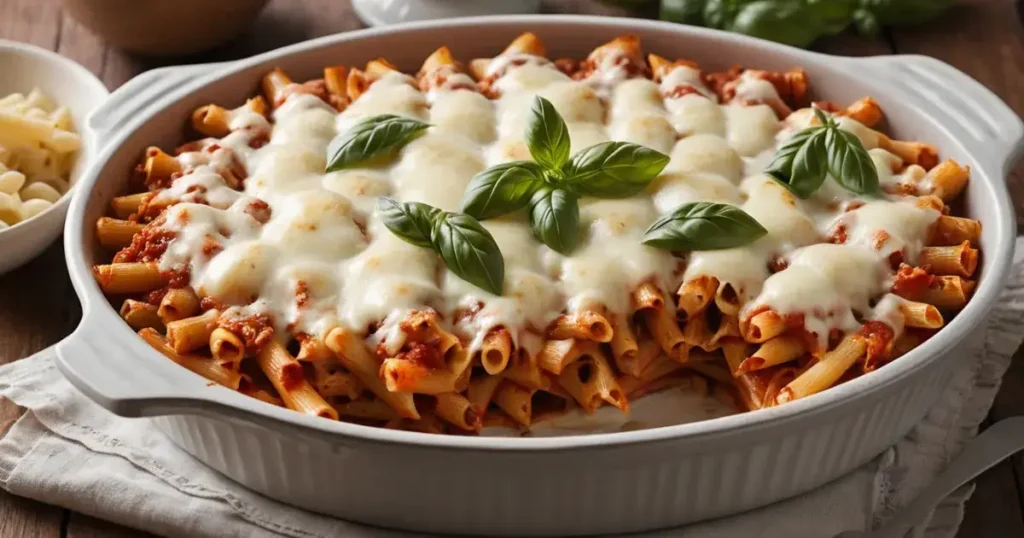Table of Contents

Easy Baked Ziti Recipe (No Meat, with Ricotta & Mozzarella)
Instructions
- If you're looking for a detailed, step-by-step guide, please read the recipe below. Each step is carefully outlined to make this baked ziti no meat recipe easy and enjoyable to follow.lternatively, you can use the table of contents at the top of the page to quickly navigate to the exact section you're interested in, whether it's the ingredients, instructions, or helpful tips for customizing your dinner.
Introduction:
There’s nothing quite like a comforting pasta dish that brings everyone to the table. Imagine a cozy dinner with family or friends, everyone diving into a warm, cheesy, and delicious baked ziti. This recipe offers all that goodness without the meat, making it a lighter yet equally satisfying choice for dinner. You’ll find the creamy layers of ricotta and mozzarella bring rich flavors that make this dish anything but boring. Let’s dive in and see how easy it is to make this meatless baked ziti that’s perfect for both busy weeknights and weekend dinners alike.
History of Baked Ziti: From Italy to American Dinner Tables

Baked ziti is more than just a delicious dish; it’s a piece of culinary history that has evolved through time, crossing borders and cultures to become a staple in Italian-American homes. This dish’s origins trace back to Italy, where pasta al forno—literally meaning “oven-baked pasta”—was a beloved meal prepared for gatherings and festive occasions.
Italian Roots and Regional Variations
In Italy, pasta al forno varies widely by region. Southern Italians often used short pasta like ziti or penne, which could easily trap the sauce and cheese within its hollow shape, allowing flavors to meld beautifully in the oven. Italians might add regional ingredients like eggplant, sausages, or rich cheeses such as Parmigiano-Reggiano or pecorino. The concept of baked pasta symbolized abundance and was ideal for celebrations and family get-togethers.
The Italian-American Twist
When Italian immigrants came to America in the late 19th and early 20th centuries, they brought traditional recipes with them. Baked ziti was quickly adapted to fit American kitchens and locally available ingredients. Marinara sauce became the go-to tomato sauce, and ricotta and mozzarella—the stars of American baked ziti—were used generously to create a creamy, hearty version that appealed to American tastes. As a result, baked ziti evolved into the comfort food we know today loved for its simplicity and rich, cheesy flavors.
Baked Ziti Today: A Comfort Classic
Today, baked ziti has secured its place as a favorite at gatherings, potlucks, and family dinners across the U.S. It’s a dish that speaks to the soul—easy to make, filling, and endlessly customizable. Whether you’re a fan of the traditional version or prefer a meatless take, baked ziti brings people together, combining Italian heritage with American warmth and hospitality.
Why You’ll Love This Meatless Baked Ziti Recipe
This prepared ziti recipe is planned to be simple yet indulgent, making it ideal for various occasions. Here are some reasons this recipe might just become your new go-to for an easy and impressive dinner:
- Perfect for All Diets: Whether you are a vegetarian or vegan seeking a meatless alternative, this formula may be a crowd-pleaser.
- Quick to Prepare: Minimal prep means you can have it ready to bake in under 20 minutes.
- Family-Friendly: Kids and adults alike will love the creamy cheese and hearty pasta.
- Affordable Ingredients: Basic ingredients make this easy on the budget, too.
With these benefits in mind, let’s look at everything you’ll need to make this delicious dish.
Ingredients You’ll Need for Baked Ziti (No Meat) with Ricotta & Mozzarella
Having the right ingredients makes all the difference in a creamy, flavorful baked ziti. Below, we’ll list each item and its quantity to make things straightforward.
Ingredient Table:
| Ingredient | Quantity | Notes |
|---|---|---|
| Ziti pasta | 1 pound | Cooked al dente |
| Ricotta cheese | 1 cup | For creamy texture |
| Mozzarella cheese | 2 cups | Shredded; save half for topping |
| Marinara sauce | 4 cups | Your favorite brand or homemade |
| Fresh basil | 1/4 cup | Chopped, for garnish (optional) |
| Italian seasoning | 1 tbsp | Adds extra flavor |
| Salt and pepper | To taste | Adjust as needed |
Step-by-Step Guide to Making the Perfect Baked Ziti (No Meat)
Follow these steps to ensure your baked ziti turns out perfectly every time:

Step 1: Prep Your Ingredients
- Cook the Pasta: Boil your ziti in salted water until it’s al dente (slightly firm when bitten). Drain and set aside.
- Preheat the Oven: Heat your oven to 375°F (190°C) so it’s ready when you are.
Step 2: Assemble the Layers
Creating layers makes each bite satisfying. Here’s how to do it:
- Layer Marinara: Spread a lean layer of marinara sauce on the foot of a preparing dish to avoid staying.
- Add Pasta and Cheese: Add half the pasta, then layer with dollops of ricotta cheese, mozzarella, and a sprinkle of Italian seasoning.
- Repeat Layers: Pour more marinara on top, followed by the rest of the pasta, remaining ricotta, and half the mozzarella.
- Top with Sauce and Cheese. Finish with a layer of marinara and the rest of the mozzarella on top.
Step 3: Bake and Serve
- Cover and Bake: Cover the dish with foil and bake for 20 minutes. This will let the cheese melt smoothly.
- Uncover and Finish: Expel the thwart, and prepare for an extra 10 minutes or until the top is bubbly and golden.
- Serve with Garnish: Top with fresh basil or Italian herbs, and serve hot.
Tips for the Best Vegetarian Baked Ziti
To make this recipe even better, here are some extra tips:
- Fresh Mozzarella: Using fresh mozzarella adds a creamy, rich flavor.
- Extra Veggies: Add spinach or mushrooms to sneak in some vegetables.
- Grated Parmesan: A light sprinkle of Parmesan on top can add depth (optional).
Serving Suggestions and Variations
Serving Ideas:
Pair this baked ziti with sides that complement its flavors:
- Garlic Bread: Serve with crusty garlic bread to soak up the sauce.
- Simple Salad: A green salad balances the richness of the ziti.
- Toppings: Offer red pepper flakes, extra cheese, or fresh herbs on the side.
Variations to Try:
Experiment with these options to make this dish your own:
- Gluten-Free: Swap in gluten-free ziti or penne pasta.
- Dairy-Free: Substitute vegan cheeses for a plant-based version.
- Add Veggies: Spinach, zucchini, or bell peppers work great.
Nutritional Information
While exact values can vary, a serving of this baked ziti will generally contain:
- Calories: ~450 per serving
- Protein: ~18g, mainly from cheese
- Carbs: ~50g, from pasta and marinara
- Fat: ~18g, from mozzarella and ricotta
This dish offers a great adjustment of protein and carbs for a satisfying dinner without being too heavy.
How to Make Your Own Marinara Sauce for Baked Ziti

Making the marinara sauce from scratch is easier than you might think and brings a fresh, homemade flavor to your baked ziti that store-bought sauces just can’t match. With a handful of pantry ingredients and a few simple steps, you can create a rich, flavorful marinara that perfectly complements the creamy ricotta and mozzarella in your baked ziti.
Why Choose Homemade Marinara?
Homemade marinara sauce isn’t just about flavor; it’s also about control. By making your sauce, you can adjust the seasoning, sweetness, and texture to suit your taste. Plus, you avoid any preservatives or added sugars that are often found in jarred sauces. The freshness of homemade marinara truly enhances your baked ziti, making each bite more flavorful and satisfying.
Simple Ingredients for Marinara Sauce
To make a classic marinara, you’ll need:
- Olive Oil: About 2 tablespoons for sautéing.
- Garlic: 3–4 cloves, finely minced, for an aromatic base.
- Crushed Tomatoes: One 28-ounce can of crushed tomatoes for a thick, rich sauce.
- Salt and Pepper: To taste, for seasoning.
- Dried Basil and Oregano: About 1 teaspoon each to add depth of flavor.
- Red Pepper Flakes (optional): A pinch if you like a hint of heat.
- Fresh Basil (optional): A handful of chopped fresh basil for added freshness at the end.
Step-by-Step Guide to Homemade Marinara Sauce
- Sauté the Garlic: In a colossal skillet or pot, warm the olive oil over medium heat. Include the minced garlic and cook for approximately 1–2 minutes, just until fragrant. Be careful not to burn it, as burned garlic can taste bitter.
- Add the Tomatoes: Pour within the pulverized tomatoes and blend well, combining them with the garlic and oil.
- Season the Sauce: Add salt, pepper, dried basil, and oregano. If you prefer a little heat, toss in a pinch of red pepper flakes. Blend everything together, permitting the flavors to merge.
- Simmer: Diminish the warm to moo and let the sauce stew for approximately 15–20 minutes, mixing sometimes. This thickens the sauce and concentrates the flavors.
- Finish with Fresh Basil: Just before removing from heat, stir in fresh basil if using. This adds a burst of bright, fresh flavor that elevates the sauce.
Tips for the Best Marinara Sauce
- Taste as You Go: Check the seasoning and adjust as needed especially salt. This allows you to fine-tune the flavor to your liking.
- Add a Touch of Sugar (Optional): If your tomatoes taste slightly acidic, add 1/2 teaspoon of sugar to balance the flavor.
- Blend for a Smoother Sauce: On the off chance that you favor a smoother surface, utilize a submersion blender to puree the sauce to your desired consistency.
Storing and Using Your Marinara
Homemade marinara sauce keeps well and can be made ahead. Essentially, store any remaining sauce in a hermetically sealed holder within the ice chest for up to a week or solidify it for up to three months. This sauce isn’t just for baked ziti; it also works beautifully with spaghetti, pizza, and even as a dipping sauce for garlic bread!
Common Mistakes to Avoid When Making Baked Ziti
Baked ziti might look like a simple, no-fuss recipe, but even small missteps can make a big difference in the final result. Avoiding common mistakes ensures that your baked ziti turns out perfectly creamy, flavorful, and satisfying every time. Here are some key pitfalls to watch out for—and easy tips to get it right!
- Overcooking the Pasta
One of the most common mistakes when making baked ziti is overcooking the pasta. Since the pasta will cook further in the oven, it’s important to boil it only until it’s just al dente—firm to the bite. Overcooked pasta becomes mushy after baking, losing the satisfying texture of perfectly cooked ziti.
Tip: Cook your pasta for about 2 minutes less than the package instructions, or until just al dente. This way, it will stay firm and hold up well during baking.
- Using Too Much Sauce
While it might be tempting to add extra marinara for a saucier ziti, too much sauce can make the dish soupy and cause the cheese layers to slide apart. The goal is a balanced, cohesive bake with just enough sauce to coat the pasta without overpowering it.
Tip: Stick to the recommended amount of sauce, spreading it evenly across layers rather than pouring in excess. This keeps the pasta moist without becoming overly saucy.
- Skipping the Layering
For a deliciously cheesy, layered baked ziti, don’t just mix everything. Proper layering helps the cheese melt evenly and creates a richer flavor in each bite. Plus, layers of sauce, pasta, ricotta, and mozzarella make the dish visually appealing and extra tasty.
Tip: Start with a base layer of marinara sauce, followed by pasta, ricotta, mozzarella, and a sprinkle of herbs. Repeat until all ingredients are used, finishing with a generous topping of mozzarella.
- Not Covering While Baking
Baking your ziti uncovered from the start can cause the top layer to dry out and even burn before the inside is heated through. Covering the dish traps moisture, allowing the pasta to cook evenly while the cheese melts beautifully.
Tip: Cover your baking dish with foil for the first 20 minutes to retain moisture. Then, remove the foil for the last 10-15 minutes to achieve a bubbly, golden-brown top.
- Skipping Seasoning Layers
Another mistake is neglecting to season each layer. Pasta, cheese, and marinara each have the advantage of a bit of salt and pepper to improve flavor. When you skip seasoning, the flavors may fall flat, especially with bland pasta and cheese.
Tip: Lightly season each layer of pasta, sauce, and cheese. For added flavor, sprinkle a bit of Italian seasoning, basil, or fresh parsley between layers.
- Using Pre-Shredded Cheese
While convenient, pre-shredded cheese often contains anti-caking agents that can prevent it from melting smoothly. For the best creamy, stretchy cheese layer, it’s worth taking a few minutes to grate your own.
Tip: Buy blocks of mozzarella and grate it yourself. Freshly grated cheese melts more smoothly and creates a richer, creamier topping.
- Forgetting to Rest Before Serving
It can be tempting to dig into the ziti as soon as it comes out of the oven, but giving it a few minutes to rest helps the layers set and makes it easier to serve.
Tip: Let your baked ziti rest for about 10 minutes after baking. This allows the cheese to cool slightly and helps the layers hold together when cut.
Storage and Reheating Tips for Leftover Baked Ziti

Leftover baked ziti can be just as delicious the next day—if stored and reheated properly. With a couple of straightforward strategies, you’ll be able to appreciate that velvety, cheesy goodness without losing any of its original flavor or texture. Here’s a complete guide on how to store and reheat your baked ziti to keep it as tasty as the day it was made.
- How to Store Leftover Baked Ziti
Legitimate capacity is key to keeping up the freshness of your heated ziti.
Here’s what you need to know:
- Refrigerator Storage: Once the baked ziti has cooled to room temperature, exchange it for an airproof holder or cover the heating dish firmly with plastic wrap or thwart. This will prevent it from drying out or retaining odors from other nourishments within the ice chest.
- Shelf Life: Baked ziti can be stored in the refrigerator for up to 3–4 days. After that, the quality may decline, and it’s best to discard any leftovers for food safety reasons.
- Freezing Baked Ziti
If you want to store your baked ziti for a longer period, freezing is a great option. Freezing baked ziti allows you to make a large batch in advance and have a homemade meal ready anytime. Here’s how to freeze it effectively:
- Freeze in Portions: To make reheating easier, consider dividing the ziti into individual portions before freezing. This way, you can take out only what you need without thawing the entire dish.
- Proper Wrapping: Wrap each portion or the entire dish in a double layer of plastic wrap, followed by a layer of aluminum foil. Alternatively, place portions in freezer-safe containers. This extra protection helps prevent freezer burn, preserving the quality of your ziti.
- Shelf Life in Freezer: Frozen baked ziti can be kept in the freezer for up to 2–3 months. Label the container with the date so you’ll know when it’s time to enjoy it.
- How to Reheat Baked Ziti
Reheating baked ziti can be done in a few ways, depending on how much time you have. Here are the best methods to ensure your ziti stays moist and flavorful:
- In the Oven (Best for Larger Portions):
- Preheat your oven to 350°F (175°C).
- Transfer the ziti to an oven-safe dish if it’s not already in one, and cover it with foil to retain moisture.
- Heat for 15–20 minutes if refrigerated, or about 30–40 minutes if reheating from frozen. Remove the foil for the last 5 minutes to allow the top to become bubbly and golden.
- In the Microwave (Quick Option for Individual Portions):
- Put a parcel of ziti in a microwave-safe dish and cover it freely with a lid or microwave-safe wrap.
- Microwave on medium control in 1-minute interims, mixing between each interim until warmed through. This strategy makes a difference in avoiding hot spots and guarantees, indeed, warming.
- Tip: Add a spoonful of marinara sauce or a few drops of water before microwaving to keep the pasta moist.
- Tips for Reheating Baked Ziti without Drying It Out
- Add Extra Sauce: If the ziti looks dry, add a small amount of marinara sauce before reheating. The added sauce will moisten the pasta and restore its flavor.
- Cover While Heating: Always cover your dish, whether using the oven or microwave. This keeps the heat contained, preventing the pasta from drying out.
Why Proper Reheating Matters
Baked ziti is a wonderful make-ahead dish, but it can lose its texture and flavor if not reheated properly. By following these tips, you’ll get that same creamy, cheesy, freshly baked taste every time you warm it up. Plus, properly reheated baked ziti is just as enjoyable, making it a perfect solution for meal prep or busy weeknight dinners.
Frequently Asked Questions (FAQ)
Can I make baked ziti without ricotta?
- Yes, you can replace ricotta with cottage cheese or omit it if you prefer a less creamy texture.
How do I store and reheat baked ziti?
- Store scraps in a hermetically sealed holder within the cooler for up to 3 days. Warm on the stove at 350°F until warmed through.
Can I freeze this baked ziti recipe?
- Absolutely. Assemble the dish without baking, then freeze. When ready, bake from frozen, adding an extra 10-15 minutes.
What vegetables can I add to this baked ziti?
- Try adding spinach, mushrooms, zucchini, or bell peppers for extra flavor and nutrition.
Can I make baked ziti without boiling the pasta first?
- Yes, you can use a no-boil method by adding extra marinara sauce or water to ensure the pasta cooks fully in the oven. Cover tightly with foil to trap moisture, and bake longer than usual (around 45–50 minutes).
What’s the best pasta to use if I don’t have ziti?
- You can substitute ziti with similar pasta shapes like penne, rigatoni, or even fusilli. Any short pasta with ridges will hold the sauce and cheese well.
Can I add vegetables to baked ziti? Which ones work best?
- Absolutely! Common vegetables for baked ziti include spinach, bell peppers, zucchini, and mushrooms. Sautéing them briefly before layering them in the ziti ensures they cook thoroughly.
How can I make baked ziti gluten-free?
- Substitute regular ziti with gluten-free pasta made from rice, corn, or chickpeas. Be cautious about cooking times, as some gluten-free pastas cook more quickly.
Is it okay to prepare baked ziti ahead of time?
- Yes, you’ll collect the ziti a day in progress and refrigerate it until you are ready to prepare. Allow it to come to room temperature before baking, or adjust the bake time if it’s cold from the fridge.
Can I make a dairy-free version of baked ziti?
- For a dairy-free version, use vegan cheeses like cashew-based ricotta and dairy-free mozzarella. There are also vegan marinara sauces available, or you can make your own.
How many people does a typical baked ziti recipe serve?
- Most baked ziti recipes serve around 6–8 people, depending on portion sizes. If you’re cooking for a crowd, consider doubling the recipe.
What’s the best way to prevent baked ziti from drying out?
- Use a generous amount of marinara sauce, cover with foil while baking, and don’t overbake. Adding extra cheese on top during the final few minutes can also keep it moist.
Can I utilize new tomatoes rather than canned ones for the marinara sauce?
- Yes, but it requires a bit more time. Blanch and peel about 4 cups of fresh tomatoes, then cook them down to thicken before following the marinara recipe.
Can I add eggs to my ricotta layer for richerness?
- Definitely, adding one egg to the ricotta cheese mixture helps it set more firmly and adds richness to the dish. Just mix the egg with the ricotta before layering.
Conclusion and Call to Action
This baked ziti recipe is your perfect solution for an easy, comforting dinner that everyone will love. Whether you’re serving it at a family dinner or making it for meal prep, this meatless option provides rich, cheesy flavors without the heaviness of meat.
Give this recipe a try, and let us know how it turns out in the comments! We’d love to hear about your favorite variations or any tips you’ve discovered.
